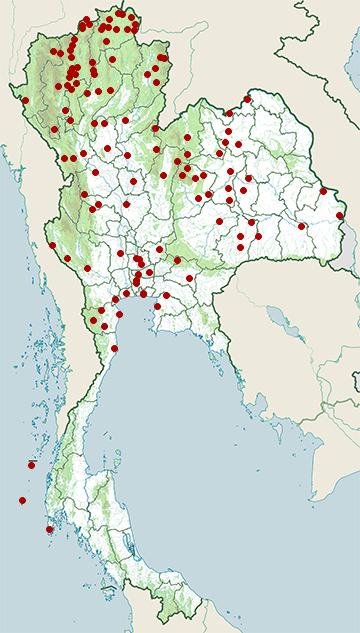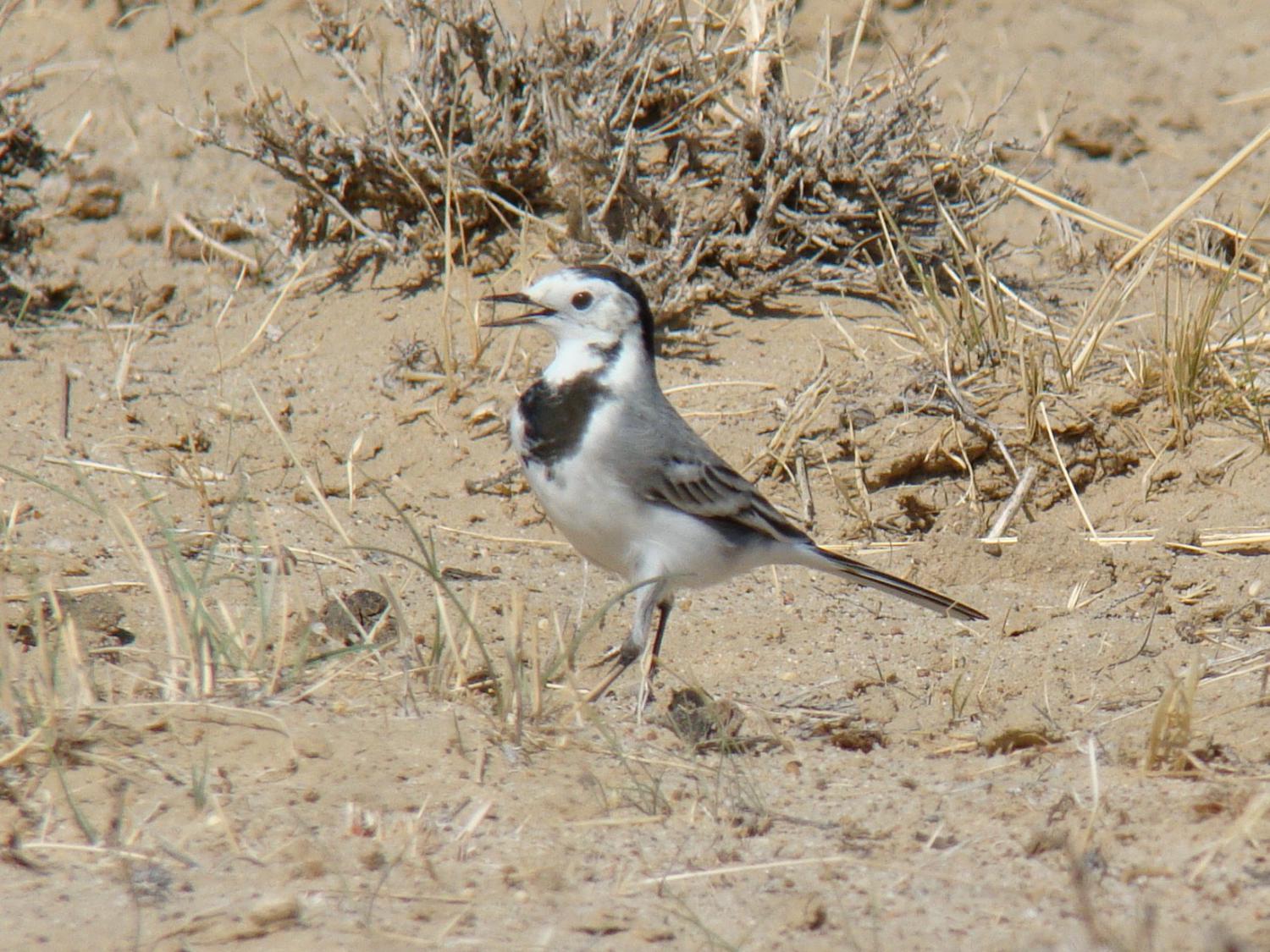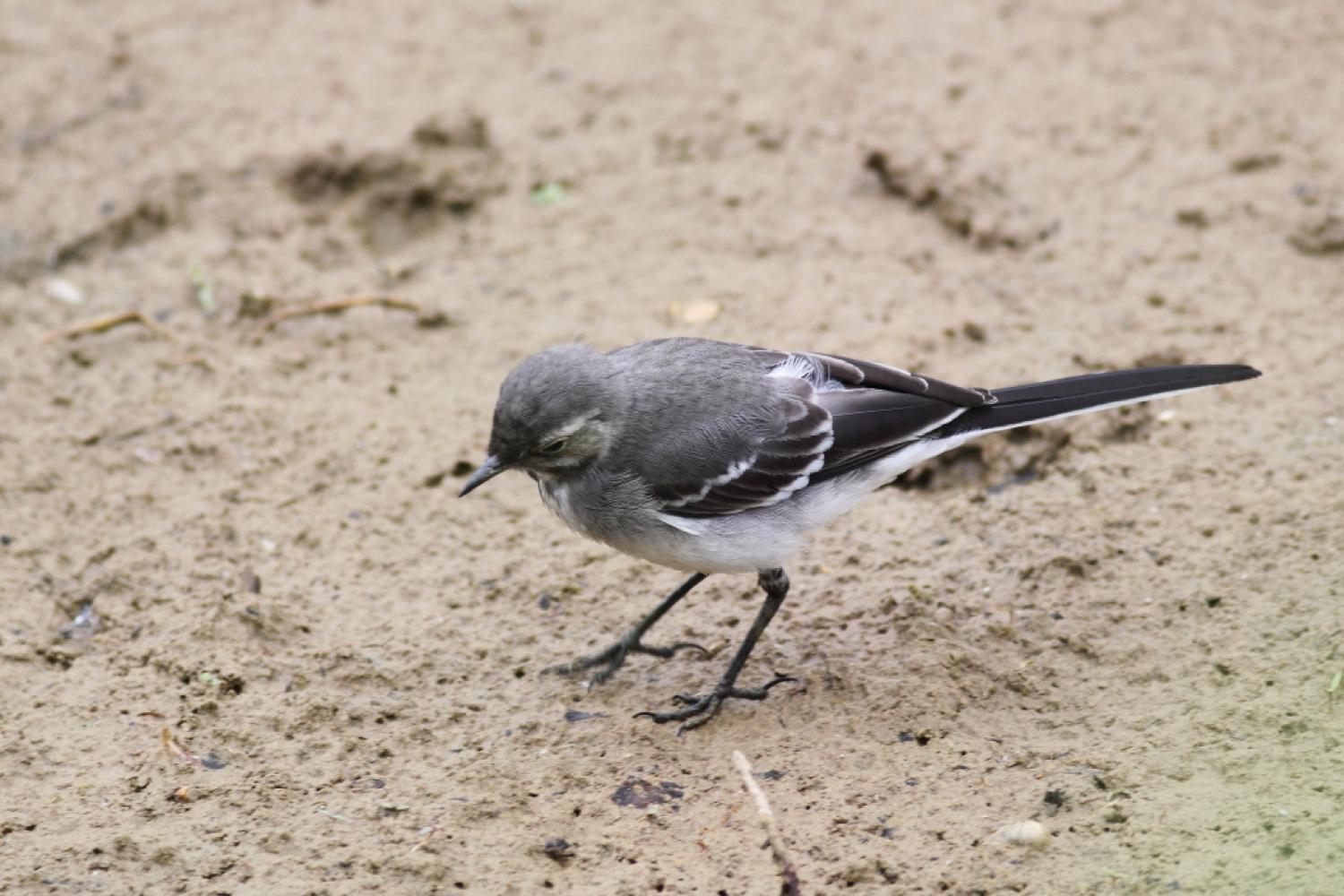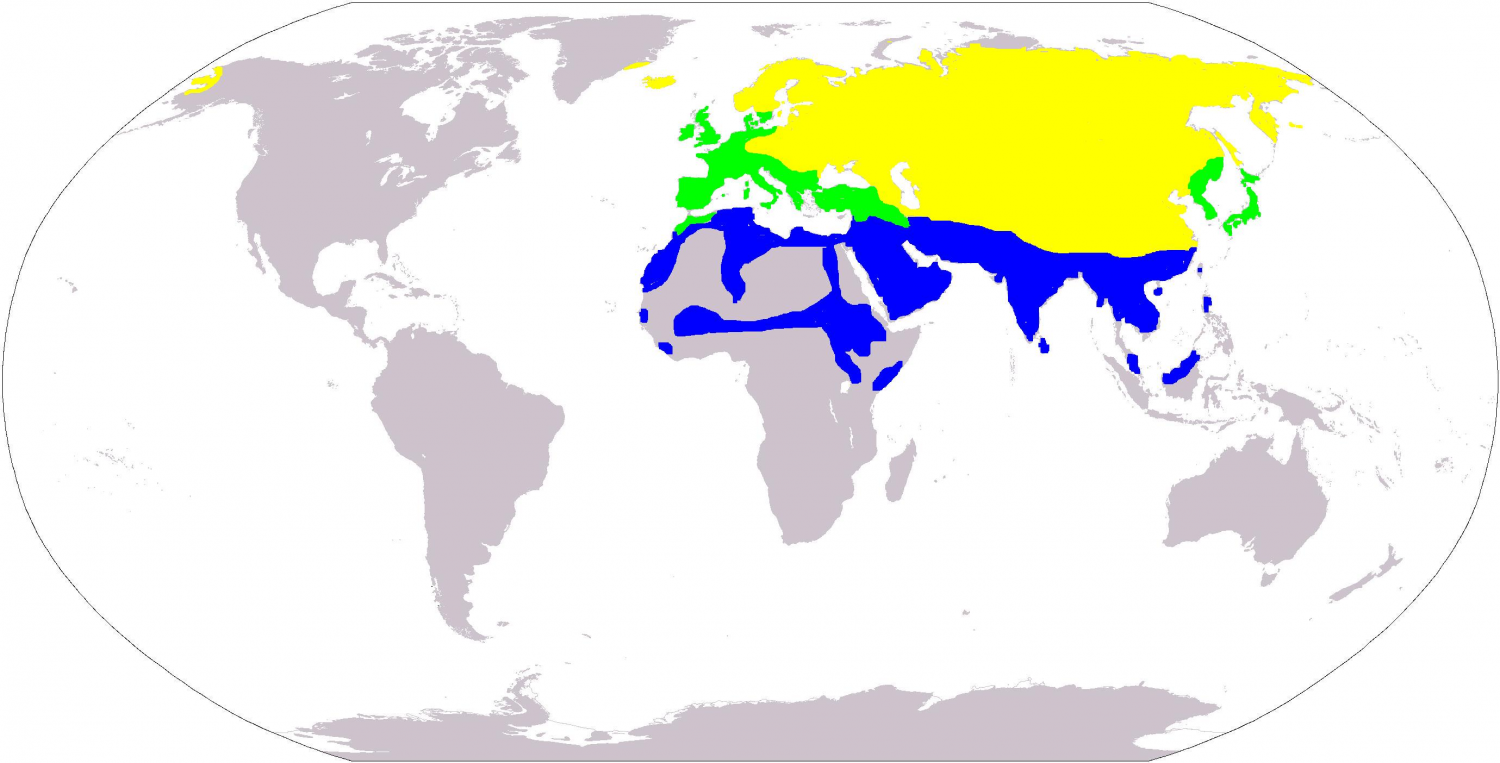Species of Thailand
White wagtail
Motacilla alba
Carolus Linnaeus, 1758
In Thai: นกอุ้มบาตร
The white wagtail (Motacilla alba) is a small passerine bird in the family Motacillidae, which also includes pipits and longclaws. The species breeds in much of Europe and the Asian Palearctic and parts of North Africa. It has a toehold in Alaska as a scarce breeder. It is resident in the mildest parts of its range, but otherwise migrates to Africa. In Ireland and Great Britain, the darker subspecies, the pied wagtail or water wagtail (M. a. yarrellii) predominates. In total, there are between 9 and 11 subspecies.
The white wagtail is an insectivorous bird of open country, often near habitation and water. It prefers bare areas for feeding, where it can see and pursue its prey. In urban areas it has adapted to foraging on paved areas such as car parks. It nests in crevices in stone walls and similar natural and man-made structures.
It is the national bird of Latvia and has featured on the stamps of several countries. Though it is 'of least concern', there are several threats against it, like being kept as pets and being used as food.
Taxonomy and systematics
The white wagtail was one of the many species originally described by Carl Linnaeus in his landmark 1758 10th edition of Systema Naturae, and it still bears its original name Motacilla alba. The Latin genus name originally meant "little mover", but certain medieval writers thought it meant "wag-tail", giving rise to a new Latin word cilla for "tail". The specific epithet alba is Latin for "white".
Within the wagtail genus Motacilla, the white wagtail's closest genetic relatives appear to be other black-and-white wagtails such as the Japanese wagtail, Motacilla grandis, and the white-browed wagtail, Motacilla madaraspatensis (and possibly the Mekong wagtail, Motacilla samveasnae, the phylogenetic position of which is mysterious), with which it appears to form a superspecies. However, mtDNA cytochrome b and NADH dehydrogenase subunit 2 sequence data suggests that the white wagtail is itself polyphyletic or paraphyletic (i.e. the species is not itself a single coherent grouping). Other phylogenetic studies using mtDNA still suggest that there is considerable gene flow within the races and the resulting closeness makes Motacilla alba a single species. A study has suggested the existence of only two groups: the alboides group, with M. a. alboides, M. a. leucopsis and M. a. personata; and the alba group, with M. a. alba, M. a. yarrellii, M. a. baicalensis, M. a. ocularis, M. a. lugens, and M. a. subpersonata.
Description
The white wagtail is a slender bird, 16.5 to 19 cm in length (East Asian subspecies are longer, measuring up to 21 cm), with the characteristic long, constantly wagging tail of its genus. Its average weight is 25 g and the maximum lifespan in the wild is about 12 years.
There are a number of other subspecies, some of which may have arisen because of partial geographical isolation, such as the resident British and Irish form, the pied wagtail M. a. yarrellii, which now also breeds in adjacent areas of the neighbouring European mainland. The pied wagtail, named for naturalist William Yarrell, exchanges the grey colour of the nominate form with black (or very dark grey in females), but is otherwise identical in its behaviour. Other subspecies, the validity of some of which is questionable, differ in the colour of the wings, back, and head, or other features. Some races show sexual dimorphism during the breeding season. As many as six subspecies may be present in the wintering ground in India or Southeast Asia and here they can be difficult to distinguish. Phylogenetic studies using mtDNA suggest that some morphological features have evolved more than once, including the back and chin colour. Breeding M. a. yarrellii look much like the nominate race except for the black back, and M. a. alboides of the Himalayas differs from the Central Asian M. a. personata only by its black back. M. a. personata has been recorded breeding in the Siddar Valley of Kashmir of the Western Himalayas. It has also been noted that both back and chin change colour during the pre-basic moult; all black-throated subspecies develop white chins and throats in winter and some black-backed birds are grey-backed in winter.
The call of the white wagtail is a sharp chisick, slightly softer than the version given by the pied wagtail. The song is more regular in white than pied, but with little territorial significance, since the male uses a series of contact calls to attract the female.
Subspecies
Nine or eleven subspecies are currently recognised. This is because the black backed wagtail may be a separate species and M. a. dukhunensis may be part of M. a. alba. Information on the plumage differences and distribution of the subspecies of the white wagtail is shown below.
| width=17% | Subspecies | width=32% |Range | width=31% | Notes | width = 20% | Image |
|---|---|---|---|
| M. a. alba | Europe from the Iberian Peninsula to Ural Mountains, Turkey, the Levant, Iceland, the Faroe Islands and Greenland's eastern coast. Some migrate to the south of Europe and Africa down as far as Kenya and Malawi. Occasionally, they are found in Britain. | Nominotypical subspecies | |
| M. a. yarrellii | Great Britain and Ireland, birds in the northern part of the range winter in Spain and North Africa, those further south are resident. | Pied wagtail or water wagtail. Has a much blacker back than the nominate race, black of throat continues on side of neck | |
| M. a. dukhunensis | West Siberian Plain – east Caspian Sea (part of Russia, Kazakhstan, Uzbekistan, Turkmenistan), winters in the Middle East, India and Bangladesh. Sometimes included in alba. | Indian pied wagtail. The upperparts of this subspecies are paler and more blue-grey than nominate, and has it has a continuous unbroken white panel on wing coverts. | |
| M. a. persica | North central and western Iran. | Intermediate between M. a. dukhunensis and M. a. personata. Often included in alba; appears to be hybrid or intergrade population. | |
| M. a. subpersonata | Non-migratory resident of Morocco | Moroccan wagtail. It has more black on the head than the nominate, and resembles a grey-backed, white-throated African pied wagtail | |
| M. a. personata | Hindu Kush, Tian Shan, Altay Mountains (northern Iran, Afghanistan, Tajikistan, Kyrgyzstan, Kazakhstan, Xinjiang) | Masked wagtail. All-black head with a white face mask | |
| M. a. alboides | Himalayas and surrounding area | This subspecies has a black back and a lot of black around the head, a white wing panel and white edges on the secondaries and tertials. | |
| M. a. baicalensis | Russia in Lake Baikal area, Mongolia, Inner Mongolia | Resembles M. a. leucopsis but grey back and less white on head and wing. | |
| M. a. ocularis | Siberia, Far Eastern (Russia, eastwards from Central Siberian Plateau) expanding into West Alaska | Similar to M. a. lugens, but with an all grey rump, clearer blue-grey and darker gray back. | |
| M. a. lugens | Russia Far East (Primorsky Krai, Khabarovsk Krai), Kamchatka Peninsula, Kuril Islands, Sakhalin, Japan (Hokkaidō, Honshū) | Black-backed wagtail or kamchatka/Japanese pied wagtail, similar to M. a. yarrellii, but has a black eyestripe and white remiges; might have a claim to constitute a distinct species. | |
| M. a. leucopsis | China, Korean Peninsula, Japan (Ryukyu Islands, Kyūshū), expanding into Japan (Honshū), Southeast Asia, India, and Oceania | Amur wagtail |
The British subspecies Motacilla alba yarellii was named after William Yarrell (1784-1856), the writer of the History of British Birds (first ed. 1843).
Distribution and habitat
This species breeds throughout Eurasia up to latitudes 75°N, only being absent in the Arctic from areas where the July isotherm is less than 4 °C. It also breeds in the mountains of Morocco and western Alaska. It occupies a wide range of habitats, but is absent from deserts. White wagtails are residents in the milder parts of its range such as western Europe and the Mediterranean, but migratory in much of the rest of its range. Northern European breeders winter around the Mediterranean and in tropical and subtropical Africa, and Asiatic birds move to the Middle East, India, and Southeast Asia. Birds from the North American population also winter in tropical Asia.
Behaviour and ecology
The most conspicuous habit of this species is a near-constant tail wagging, a trait that has given the species, and indeed the genus, its common name. In spite of the ubiquity of this behaviour, the reasons for it are poorly understood. It has been suggested that it may flush prey, or signal submissiveness to other wagtails. A study in 2004 has suggested instead that it is a signal of vigilance to potential predators.
Diet and feeding
The exact composition of the diet of white wagtails varies by location, but terrestrial and aquatic insects and other small invertebrates form the major part of the diet. These range from beetles, dragonflies, small snails, spiders, worms, crustaceans, to maggots found in carcasses and, most importantly, flies. Small fish fry have also been recorded in the diet. The white wagtail is somewhat unusual in the parts of its range where it is non-migratory as it is an insectivorous bird that continues to feed on insects during the winter (most other insectivorous birds in temperate climates migrate or switch to more vegetable matter).
Breeding
White wagtails are monogamous and defend breeding territories. The breeding season for most is from April to August, with the season starting later further north. Both sexes are responsible for building the nest, with the male responsible for initiating the nest building and the female for finishing the process. For second broods in the subspecies personata the female alone builds the nest, which is a rough cup assembled from twigs, grass, leaves and other plant matter, as the male is still provisioning the young. It is lined with soft materials, including animal hair. The nest is set into a crevice or hole—traditionally in a bank next to a river or ditch—but the species has also adapted to nesting in walls, bridges and buildings. One nest was found in the skull of a walrus. White wagtails will nest in association with other animals: particularly, where available, the dams of beavers and also inside the nests of golden eagles. Around three to eight eggs are laid, with the usual number being four to six. The eggs are cream-coloured, often with a faint bluish-green or turquoise tint, and heavily spotted with reddish brown; they measure, on average, 21 x 15 mm. Both parents incubate the eggs, although the female generally does so for longer and incubates at night. The eggs begin to hatch after 12 days (sometimes as late as 16 days). Both parents feed the chicks until they fledge after between 12 and 15 days, and the chicks are fed for another week after fledging.
Though it is known to be a host species for the common cuckoo, the white wagtail typically deserts its nest if it has been parasitised. Moksnes et al. theorised that this occurs because the wagtail is too small to push the intruding egg out of the nest, and too short-billed to destroy the egg by puncturing it.
Status
This species has a large range, with an estimated extent of more than 10 million km2 (3.8 million sq mi). The population size is between 130 and 230 million.
Population trends have not been quantified, but the species is not believed to approach the thresholds for the population decline criterion of the IUCN Red List (i.e. declining more than 30% in ten years or three generations). For these reasons, the species is evaluated to be of least concern. The population in Europe appears to be stable. The species has adapted well to human changes to the environment and has exploited human changes such as man-made structures that are used for nesting sites and increased open areas that are used for foraging. In a number of cities, notably Dublin, large flocks gather in winter to roost. They are therefore rated as of least concern. However, they are caught for sport and often then placed into collections. They are also kept as pets and eaten as food. Climate change may be affecting the time of their migration.
Culture
They have featured on stamps from Bahrain, Belarus, Belgium, Finland, Georgia, United Kingdom, Hong Kong, Hungary, Iceland, Iran, Ireland, Israel, Jersey, Kuwait, Latvia, Norway, Vietnam and Poland. The white wagtail is the national bird of Latvia, and has been often mentioned in Latvian folk songs.
This article uses material from Wikipedia released under the Creative Commons Attribution-Share-Alike Licence 3.0. Eventual photos shown in this page may or may not be from Wikipedia, please see the license details for photos in photo by-lines.
Category / Seasonal Status
Wiki listed status (concerning Thai population): Winter visitor
BCST Category: Recorded in an apparently wild state within the last 50 years
BCST Seasonal statuses:
- Non-breeding visitor
- Resident or presumed resident
Scientific classification
- Kingdom
- Animalia
- Phylum
- Chordata
- Class
- Aves
- Order
- Passeriformes
- Family
- Motacillidae
- Genus
- Motacilla
- Species
- Motacilla alba
Common names
- Thai: นกอุ้มบาตร
Subspecies
Motacilla alba alba (nominate), Carolus Linnaeus, 1758
Range: Europe from the Iberian Peninsula to Ural Mountains, Turkey, the Levant, Iceland, the Faroe Islands and Greenland's east coast. Some migrate to the south of Europe and Africa down as far as Kenya and Malawi
Motacilla alba alboides, Brian Houghton Hodgson, 1836
Range: Himalayas and surrounding area. This subspecies has a black back and a lot of black around the head, a white wing panel and white edges on the secondaries and tertials.
Motacilla alba baicalensis, Robert Swinhoe, 1871
Range: Russia in Lake Baikal area, Mongolia, Inner Mongolia. Resembles M. a. leucopsis but grey back and less white on head and wing.
Motacilla alba dukhunensis, Colonel William Henry Sykes, 1832
Common name: Indian pied wagtail
Range: West Siberian Plain – east Caspian Sea (part of Russia, Kazakhstan, Uzbekistan, Turkmenistan), winters in the Middle East and India. Sometimes included in alba. The upperparts of this subspecies are paler and more blue-grey than nominate, and has it has a continuous unbroken white panel on wing coverts.
Motacilla alba leucopsis, John Gould, 1838
Common name: Amur wagtail
Range: China, Korean Peninsula, Taiwan, Japan (Ryukyu Islands, Kyushu), expanding into Japan (Honshu), Southeast Asia, India, and Oceania
Motacilla alba lugens, Constantin Wilhelm Lambert Gloger, 1829
Common name: Black-backed wagtail, kamchatka/Japanese pied wagtail
Range: Russia Far East (Primorsky Krai, Khabarovsk Krai), Kamchatka Peninsula, Kuril Islands, Sakhalin, Japan (Hokkaido, Honshu) . Similar to M. a. yarrellii, but has a black eyestripe and white remiges; might have a claim to constitute a distinct species.
Motacilla alba ocularis, Robert Swinhoe, 1860
Range: Siberia, Far Eastern (Russia, eastwards from Central Siberian Plateau) expanding into West Alaska.
Motacilla alba persica, William Thomas Blanford, 1876
Range: North central and western Iran. Intermediate between M. a. dukhunensis and M. a. personata. Often included in alba; appears to be hybrid or intergrade population.
Motacilla alba personata, John Gould, 1861
Common name: Masked wagtail
Range: Hindu Kush, Tian Shan, Altay Mountains (northern Iran, Afghanistan, Tajikistan, Kyrgyzstan, Kazakhstan, Xinjiang). All-black head with a white face mask
Motacilla alba subpersonata, Edmund Gustavus Bloomfield Meade-Waldo, 1901
Common name: Moroccan wagtail
Range: Non-migratory resident of Morocco. It has more black on the head than the nominate, and resembles a grey-backed, white-throated African pied wagtail
Motacilla alba yarrellii, John Gould, 1837
Common name: Pied wagtail
Range: Great Britain and Ireland, birds in the northern part of the range winter in Spain and North Africa, those further south are resident. Has a much blacker back than the nominate race, black of throat continues on side of neck
Conservation status

Least Concern (IUCN3.1)
Photos
Please help us review the bird photos if wrong ones are used. We can be reached via our contact us page.
Range Map

- Ban Phai District, Khon Kaen
- Bang Ban District, Phra Nakhon Si Ayutthaya
- Bang Pa In District, Phra Nakhon Si Ayutthaya
- Bang Phra Non-Hunting Area
- Bang Pu Recreation Centre
- Bangkok Province
- Borabue District, Maha Sarakham
- Bueng Boraped Non-Hunting Area
- Chae Son National Park
- Chiang Dao District, Chiang Mai
- Chiang Dao Wildlife Sanctuary
- Chiang Khong District, Chiang Rai
- Chiang Saen District, Chiang Rai
- Chum Ta Bong District, Nakhon Sawan
- Doi Inthanon National Park
- Doi Lang
- Doi Lo District, Chiang Mai
- Doi Pha Hom Pok National Park
- Doi Phu Kha National Park
- Doi Suthep - Pui National Park
- Doi Tao District, Chiang Mai
- Fang District, Chiang Mai
- Hang Chat District, Lampang
- Huai Chorakhe Mak Reservoir Non-Hunting Area
- Huai Nam Dang National Park
- Kabin Buri District, Prachinburi
- Kaeng Khoi District, Saraburi
- Kaeng Krachan National Park
- Kanthararom District, Sisaket
- Kantharawichai District, Maha Sarakham
- Kaset Sombun District, Chaiyaphum
- Khao Sam Roi Yot National Park
- Khao Yai National Park
- Khemarat District, Ubon Ratchathani
- Khon San District, Chaiyaphum
- Khun Chae National Park
- Khun Korn Forest Park
- Khun Nan National Park
- Khun Tan District, Chiang Rai
- Kumphawapi District, Udon Thani
- Laem Pak Bia
- Lam Nam Kok National Park
- Lan Sak District, Uthai Thani
- Mae Ai District, Chiang Mai
- Mae Chan District, Chiang Rai
- Mae Charim National Park
- Mae Mo District, Lampang
- Mae Ping National Park
- Mae Rim District, Chiang Mai
- Mae Sot District, Tak
- Mae Taeng District, Chiang Mai
- Mae Wong National Park
- Mueang Chaiyaphum District, Chaiyaphum
- Mueang Chiang Mai District, Chiang Mai
- Mueang Chiang Rai District, Chiang Rai
- Mueang Kamphaeng Phet District, Kamphaeng Phet
- Mueang Khon Kaen District, Khon Kaen
- Mueang Lampang District, Lampang
- Mueang Lamphun District, Lamphun
- Mueang Nan District, Nan
- Mueang Nong Khai District, Nong Khai
- Mueang Nonthaburi District, Nonthaburi
- Mueang Pan District, Lampang
- Mueang Pathum Thani District, Pathum Thani
- Mueang Phayao District, Phayao
- Mueang Phetchabun District, Phetchabun
- Mueang Phitsanulok District, Phitsanulok
- Mueang Phuket District, Phuket
- Mueang Samut Sakhon District, Samut Sakhon
- Mueang Samut Songkhram District, Samut Songkhram
- Mueang Sukhothai District, Sukhothai
- Mueang Suphanburi District, Suphan Buri
- Mueang Surin District, Surin
- Mueang Tak District, Tak
- Mueang Udon Thani District, Udon Thani
- Mueang Uttaradit District, Uttaradit
- Nam Nao National Park
- Non Sang District, Nong Bua Lamphu
- Nong Bong Khai Non-Hunting Area
- Nong Song Hong District, Khon Kaen
- Nong Waeng Non-Hunting Area
- Nong Ya Plong District, Phetchaburi
- Omkoi Wildlife Sanctuary
- Op Khan National Park
- Pa Sang District, Lamphun
- Pai District, Mae Hong Son
- Pha Daeng National Park
- Pha Taem National Park
- Phan District, Chiang Rai
- Phanat Nikhom District, Chonburi
- Phimai District, Nakhon Ratchasima
- Phra Nakhon Si Ayutthaya District, Phra Nakhon Si Ayutthaya
- Phu Chi Fa Forest Park
- Phu Foi Lom National Park
- Phu Hin Rong Kla National Park
- Phu Khiao District, Chaiyaphum
- Phu Khiao Wildlife Sanctuary
- Phu Kradueng National Park
- Phu Suan Sai National Park
- Rattanawapi District, Nong Khai
- Sai Yok National Park
- Salak Pra Wildlife Sanctuary
- Salawin National Park
- Samut Prakan Province
- San Sai District, Chiang Mai
- Sanam Bin Reservoir Non-Hunting Area
- Santi Suk District, Nan
- Satuek District, Buriram
- Si Satchanalai District, Sukhothai
- Si Satchanalai National Park
- Similan Islands
- Surin Islands
- Taksin Maharat National Park
- Taphan Hin District, Phichit
- Tha Yang District, Phetchaburi
- Thanyaburi District, Pathum Thani
- Thong Pha Phum National Park
- Wang Saphung District, Loei
- Wiang Chai District, Chiang Rai
- Wiang Kaen District, Chiang Rai




